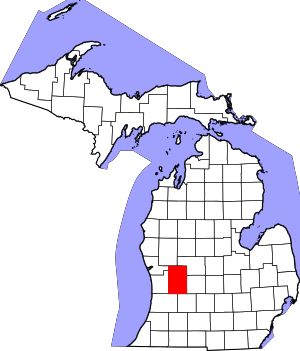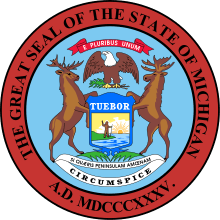Wyoming, Michigan
Wyoming is a city in Kent County, Michigan. As of the 2010 census, the city has a total population of 72,125, which makes it the 3rd largest community or city in West Michigan, the 14th largest city in the state of Michigan, and the 18th largest community in the state as well as the largest suburb of Grand Rapids.
Wyoming, Michigan | |
|---|---|
City | |
| City of Wyoming | |
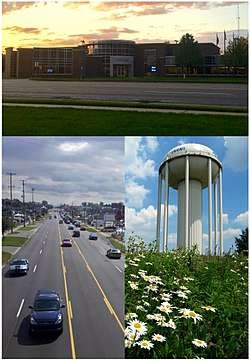 From top, left and right: Wyoming City Hall. Looking east down 28th Street, the city's main commercial route. Water tower near Gezon Park. | |
 Flag  Seal | |
| Motto(s): City of Vision and Progress | |
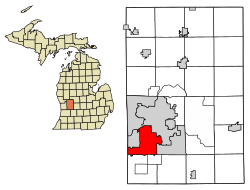 Location of Wyoming within Kent County, Michigan | |
 Wyoming, Michigan Location in the United States | |
| Coordinates: 42°54′49″N 85°42′20″W | |
| Country | |
| State | |
| County | Kent |
| Government | |
| • Type | Council-Manager |
| • Mayor | Jack Poll |
| • City Manager | Curtis Holt |
| Area | |
| • Total | 24.95 sq mi (64.62 km2) |
| • Land | 24.74 sq mi (64.07 km2) |
| • Water | 0.22 sq mi (0.56 km2) |
| Elevation | 643 ft (196 m) |
| Population | |
| • Total | 72,125 |
| • Estimate (2019)[3] | 75,667 |
| • Density | 3,058.98/sq mi (1,181.09/km2) |
| Time zone | UTC-5 (EST) |
| • Summer (DST) | UTC-4 (EDT) |
| ZIP codes | 49509, 49519, 49418, 49503, 49508, 49548 |
| Area code(s) | 616 |
| FIPS code | 26-88940[4] |
| GNIS feature ID | 1616863[5] |
| Website | www |
In 1832 the area was settled and organized under the Byron Township. In 1848 the township split the northern half being called Wyoming Township and has experienced population growth every census since 1890. Wyoming became a city in 1959 after a period of disputes surrounding annexation as well as water and sewer usage.
During the post-war period, Wyoming saw tremendous suburban development, with many prominent residential and commercial projects occurring at this time. By the 1990s, growth in Wyoming had halted as urban sprawl had passed the city, with many businesses ultimately closing during the Great Recession. Into the 2010s, development began to restart in the southwestern panhandle while efforts to .
History
Settlement
Through the 1800s, Wyoming would primarily remain an agricultural location and its development occurred near transportation routes in the region.[6] The area that is now the city of Wyoming was the second location settled by European-Americans in Kent County.[7] Robert Howlett, Luther Lincoln Amos Gordon and Stephen Tucker were some of the first settlers in the fall of 1832[7] with many settling near Buck Creek.[6] Lincoln built the first log shanty in the area in the fall of 1832 while Tucker and Native Americans constructed the first established house for his family in March 1833.[7] The first settlers had a successful harvest, constructing gristmills and sawmills on Buck Creek a year later in 1833.[7][6] In late 1835, the first wedding occurred with Sylvester Hills and Harriet Burton.[7]
Byron Township (1836–1848)
The town was first organized as Byron Township on May 2, 1836 and was headquartered at the home of Charles H. Oakes in what is now the city of Grandville.[7] It was this year that one of Wyoming's most notable pioneers, Justice C. Rogers, established his homestead on what is now the southwest corner of 28th Street and Clyde Park Avenue.[8]
The following year in 1837, the launch of the pole boat propelled by a quant, the Cinderella, was celebrated as a major development for the town.[7] A framed house Rogers constructed in the spring of 1836 and was destroyed by a tornado in September 1836.[9] Rogers Mansion was then constructed with the second story being finished in 1839.[8]
Wyoming Township (1848–1959)
On April 3, 1848 the 72 square miles (190 km2) township of Byron divided in half during , with the name of Wyoming being used for the northern 36 square miles (93 km2) portion where the majority of the population was settled.[7] with many settling near Buck Creek.[10] At the time of division, about 500 people lived in Wyoming while a little less than 200 lived in Byron.[10] The name came from the Wyoming County, New York from which the majority of the residents came during the first 16 years.[10] Two years later in 1850, the population of Wyoming Township was counted at 543 people.[11]
In 1870 a settlement known as Fisher's Station developed around a station on the Grand Rapids and Indiana Railroad. A post office was constructed in 1871 and the area was platted in December 1873.[7][12] The population of Wyoming Township grew to 2,008 in 1874 while the population of Fisher's Station was 65 in 1888.[7]
Suburban growth
Wyoming began to grow as a suburb of Grand Rapids in 1890 with the city's next major area of development occurring in the northeast section of the township[13] with much of the city's population moving southward in the early 1900s.[14] The City of Grand Rapids started annexing portions of the township and by 1891 had annexed one square mile (2.6 km2) of the city from Division to Clyde Park and from Hall to Burton.[13] In 1902, the Grand Rapids, Holland and Chicago Railway promoted the creation of more plats in the Galewood, Urbandale and Burlingame (GUB) neighborhoods, with the railway providing transportation to downtown Grand Rapids in fifteen minutes.[13] From 1890 to 1906, thirty-two plats were in the GUB neighborhoods.[13] Another section of Wyoming was annexed by Grand Rapids in 1916 that involved half-mile from Burton to Alger and from Clyde Park to Division.[13] Following the end of World War I in 1918, there was a large increase in the platting of residential properties, especially the neighborhoods of Godwin Heights, Home Acres and Wyoming Park, with plat proposals occurring during every town meeting at the time.[13][15]
With Wyoming developing at such a rapid pace, the Grand Rapids city officials and affiliated business leaders attempted to deter the development of industry in Wyoming, fearing that Grand Rapids would lose skilled workers and wages would increase.[15] One major incident of Grand Rapids preventing industrial development in Wyoming occurred in the early-1920s when Ford Motor Company attempted to purchase an unfinished picric acid on the west side of 44th Street and Clyde Park Avenue that was being constructed during World War I.[15] Kendall Furniture quickly purchased the property to before Ford could acquire the site, later selling the property for tax purposes.[15]
As a result of suburbanization the population of Wyoming had increased over 250% between 1920 and 1930, from 6,501 to 16,931.[15]
General Motors promotes growth
As the Great Depression affected the world's economy in the 1930s, Grand Rapids saw little industrial development as there was no demand for furniture, the city's main economic product.[16] During the economic depression, at least twenty-five percent of Wyoming residents were unemployed.[17] Former Mayor of Grand Rapids George P. Tilma was elected supervisor of Wyoming Township in 1932 and was tasked with modernizing the developing suburban community from a rural town system.[17]
General Motors sought to construct a new facility in Grand Rapids, though there were no areas for development or future expansions, so the cities of Grand Rapids and Wyoming collaborated to have General Motors purchase land in Wyoming while Grand Rapids supplied utilities to the site.[16] Tilma's expertise was instrumental in both secretly negotiating with Grand Rapids on utility work and with obtaining approval of the site by General Motors.[17] The General Motors plant began construction on January 22, 1936 and the first metal stamps were shipped from the factory on June 1, 1936.[16] The first enrollment date for employees on April 6, 1936 saw a line of workers spanning nearly 1.5 miles (2.4 km) from the factory's entrance west of Buchanan Avenue and 36th Street, east to Division Avenue and then north 1 mile (1.6 km) to 28th Street.[16]
Following the construction of the General Motors stamping plant, development on Division Avenue increased extensively, with a new Kelloggsville High School being opened in September 1936 and a new Godwin Heights High School being approved in January 1937.[16] Supervisor Tilma died suddenly in his office in April 1937 with his death being attributed to an intracerebral hemorrhage.[17] As World War II began, Reynolds Metals opened a plant in the township that was initially to develop airplane material in 1942.[18]
Post-war growth, push towards cityhood
Following World War II, Wyoming developed so rapidly that mobile homes began to appear on vacant properties throughout the city, with an ordinance being passed in 1947 to prevent this.[17]
As Wyoming moved towards cityhood, the township purchased 5 acres (20,000 m2) of land from Judy Devine in December 1947 on the northeast corner of 28th Street and DeHoop Avenue, establishing the area as the town center of Wyoming due to the increased development on 28th Street.[17][18] A year later in 1948, Lake Alexander was drained and converted into what is now Jackson Park.[14] In May 1948, a committee was created by the township which recommended incorporating Wyoming into a city.[17] As Wyoming pursued incorporation, Grand Rapids increased annexation attempts, with the annexation of GUB being defeated in April 1949.[17]
The 1950s was the decade of Wyoming's fastest development, with homes developing so quickly that the township experienced difficulties providing proper utilities to homes.[17] Multiple wells were drilled throughout the area to provide water to the developing community after the water supply from Grand Rapids was discontinued, temporarily sparking political controversy surrounding water supplies.[17] The township board approved of a route for U.S. Route 131 through Wyoming in July 1952 and 28th Street was widened from two to four lanes shortly after.[17] In August 1956, a vote for incorporation into a city was narrowly defeated and the Ivanrest area was annexed by Grandville.[17] Rogers Department Store, one of the largest department stores in Michigan at the time, opened on 28th Street in 1955.[19] On November 6, 1958, voters approved the incorporation of Wyoming into a city.[17]
City of Wyoming (1959–present)
In the 1960s, the city was able to launch several projects. The first was a sewage plant to take care of issues from the state in regards to dumping it in the Buck Creek and Grand River. The next was the completion of the Water Plant in Holland with a pipeline to the city.
New developments occurred over the decade on 28th Street, with free vehicle parking drawing some shoppers away from Grand Rapids.[20] One major project was Rogers Plaza, which opened in August 1961 as the first indoor shopping mall in Michigan and one of the first in the United States, including stores such as S. S. Kresge, W. T. Grant, Kroger, A&P, Cunningham Drug and Montgomery Ward.[17][20][21] The neighboring Wyoming Village Mall opened later in 1961 and was anchored by Wurzburg's.[20] Flowerland Fruitbasket also opened in 1961 providing lawn care tools, flowers and outdoor furniture for the developing suburban homes.[20] Gordon Food Service moved from Grand Rapids to Wyoming in 1962.[20] Three annexation attempts by Grand Rapids were also defeated in that year; the Kent County Airport, the Blackburn neighborhood and Buchanan neighborhood.[17] Studio 28 opened on the 28th Street corridor in 1965 and expanded in size over decades into the world's first multiplex and the largest multiplex in the world in 1988.[22] In July 1966, the Lake Michigan pipeline to Wyoming began to supply water to the city, a major accomplishment after years of difficulties with low-quality wells.[17] By the end of the decade, the city faced fund shortages and multiple income tax proposals were turned down.[17] Wyoming began to establish many municipal facilities in the 1970s, including a public works building, a centralized fire station, a combined Police-Justice building and a new public library.[17]
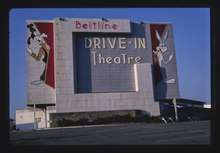
By the 1980s, the city became concerned about the quality of developments, with adult bookstores and massage parlors appearing.[17] In 1990, Reynolds Metals closed their operations in the city.[18] Following the 1999 opening of Rivertown Crossings Mall in Grandville near the southwest border of Wyoming, many commercial tenants left the 28th Street corridor.[19][23] The once-popular Rogers Department Store closed in 2003.[20] More business was lost in the late-2000s into the 2010s during the great recession, with the GM Fisher Body Plant closed due to budget cuts by General Motors. Much of the commercial atmosphere of 28th Street also dwindled down, with Studio 28 closing in 2008[24] and vacancy rates up to nearly 40% in 2011.[25]
In the mid-2010s, development spread to southern Wyoming. Gordon Foods expanded its headquarters in 2012[26] and development occurred near the recently built Metro Health Hospital. The 28 West plan was also initiated to make 28th Street a more pedestrian-friendly corridor while also centralizing the development of food, retail and entertainment projects in the city's center, effectively creating a downtown area.[27]
Businesses
As of the 2000 census, there are presently 10 types of industries in the city. Manufacturing accounts for 30%, retail 16%, education, health, and social services 15%, with the next five industries accounting for 6%, and transportation, warehousing, utilities accounting for 3% of business in the city. The manufacturing segment is unique in that it is the largest in West Michigan. It currently produces auto parts, industrial machinery, commercial printing, plastics, food processing, electronics, tool and dies, concrete supplies, and fire engines.
After Grandville allowed development of a new 6-anchor shopping complex, Rivertown Crossings Mall, and the related development, many major retail businesses in Wyoming folded, including long-standing Roger's Department Store, its successor, and most tenants of Rogers Plaza. The city of Wyoming formed a Downtown Development Authority in an effort to help support the city in keeping businesses in the area in 1999.
In the 2000s, plans were being made to revitalize the 28th Street corridor.[27] In 2013, the City of Wyoming introduced the 28 West plan,[29] a plan to develop downtown Wyoming along 28th Street into a more pedestrian friendly environment that will provide food, retail and entertainment.[27] In June 2016, plans began moving forward on the 28 West plan with the demolishing of part of the Wyoming Village Mall and the creation of a new road through the surrounding parking lots to attract developers.[27]
Largest employers
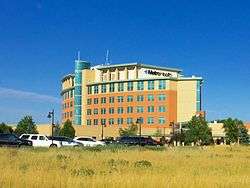
According to the City's 2017 Comprehensive Annual Financial Report, the largest employers in the city are:[30]
| # | Employer | # of Employees | % of city employment |
|---|---|---|---|
| 1 | Metro Health Hospital | 2,567 | 4.53% |
| 2 | Gordon Food Service | 2,154 | 3.80% |
| 3 | UPS | 1,216 | 2.15% |
| 4 | Michigan Turkey Products | 788 | 1.39% |
| 5 | GM Components Holdings | 700 | 1.24% |
| 6 | Benteler | 691 | 1.22% |
| 7 | Consumers Energy | 484 | 0.85% |
| 8 | Wyoming Public Schools | 477 | 0.84% |
| 9 | Country Fresh | 401 | 0.71% |
| 10 | City of Wyoming | 334 | 0.59% |
Arts and culture
The city has 21 parks that cover about 665 acres (2.69 km2) which offer a multitude of activities.[28][31] The parks department has been active in the past decade in redeveloping the parks in the city. Many parks have been rebuilt which included adding new equipment, splash pads, and facilities. They have also added a few new facilities including a small skateboard park near one of the highest densities of the city. The city also offers a Senior Center that provides activities for the older citizens of the city and the region as a whole.[32] Along with the parks is the Kent Trails system that converted abandoned rail lines to bike paths. It is a collaborative effort between multiple local governments.[28][33] The most recent addition to the Wyoming Park System is the Dog Park located next to Marquette Park at the very northern edge of the city. It is a privately funded park with access controls to restrict usage to registered members.[34]
In 2002, the new Wyoming Public Library was built and is owned by the city but run by the Kent District Library System. It is a 48,950-square-foot (4,548 m2) facility with over 112,046 items. The library branch is also the highest attended in the Kent District system with 670,842 items checked out and 439,599 visits in 2009. The library currently has around 76% of the population holding a card to use the facility.[35] The building houses the Wyoming Historical Commission that provides history of the city.[36] Along with Historical Commission room, it houses the library for the blind and an art gallery.
Starting in 2005, the Wyoming-Kentwood Chamber of Commerce put together the 28th Street Metro Cruise that draws in automobile enthusiasts from the region. It currently spans 15 miles (24 km) from its start in Grandville at Wilson and 28th where drivers gather and drive to the cruise's end in Cascade Township. The cruise runs on Friday and Saturday on the last weekend of August.[28][37]
Geography
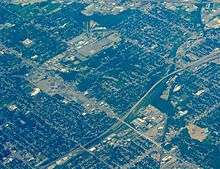
The city is situated southwest of Grand Rapids and south of the Grand River.[38] Buck Creek spans across the city and created a valley of dark loam soil that was used for historically used for farming, while elevated land above the valley is dense clay soil.[38]
Grandville and Georgetown Township in Ottawa County are to the west. Byron Township is to the south and the city of Kentwood to the east. U.S. Highway 131 (US 131) runs through the eastern side of the city and Interstate 196 (I-196) runs southwest–northeast along the Grand River. The newly completed M-6 (Paul B. Henry Freeway) runs along the south side of the city and connects I-196 with US 131 and I-96. M-11 runs east–west through the north of the city, also connecting with I-196, US 131, and I-96.
According to the United States Census Bureau, the city has a total area of 24.87 square miles (64.41 km2), of which, 24.64 square miles (63.82 km2) is land and 0.23 square miles (0.60 km2) is water.[39]
Weather
Wyoming is located just on the edge of the snow belt, where more snow tends to fall from lake effect snow coming off Lake Michigan. The lake also helps the area east of Wyoming in keeping warmer than usual. The record temperature in the area was 102 °F (39 °C) as its high in June and its low was set in January at −22 °F (−30 °C). Sunshine tends to be around 46% of the time with 43% of the year of temperatures reaching at least 65 °F (18 °C). Almost 40% the temperature dips below 32 °F (0 °C).
| Climate data for Wyoming, Michigan | |||||||||||||
|---|---|---|---|---|---|---|---|---|---|---|---|---|---|
| Month | Jan | Feb | Mar | Apr | May | Jun | Jul | Aug | Sep | Oct | Nov | Dec | Year |
| Average high °F | 30 | 32 | 42 | 57 | 69 | 79 | 83 | 81 | 73 | 61 | 46 | 34 | 57 |
| Average low °F | 16 | 17 | 25 | 36 | 46 | 56 | 60 | 59 | 51 | 41 | 31 | 21 | 38 |
| Average rainfall inches | 2.0 | 1.5 | 2.6 | 3.5 | 3.0 | 3.6 | 3.5 | 3.4 | 3.7 | 2.8 | 3.3 | 2.6 | 35.5 |
| Average snowfall inches | 20.2 | 11.9 | 10.0 | 3.0 | 0 | 0 | 0 | 0 | 0 | .7 | 7.7 | 18.1 | 71.6 |
| Average high °C | −1 | 0 | 6 | 14 | 21 | 26 | 28 | 27 | 23 | 16 | 8 | 1 | 14 |
| Average low °C | −9 | −8 | −4 | 2 | 8 | 13 | 16 | 15 | 11 | 5 | −1 | −6 | 4 |
| Average rainfall mm | 51 | 38 | 66 | 89 | 76 | 91 | 89 | 86 | 94 | 71 | 84 | 66 | 900 |
| Average snowfall cm | 51 | 30 | 25 | 7.6 | 0 | 0 | 0 | 0 | 0 | 1.8 | 20 | 46 | 182 |
| Source: Weatherbase[40] | |||||||||||||
Surrounding municipalities
Demographics
| Historical population | |||
|---|---|---|---|
| Census | Pop. | %± | |
| 1960 | 45,829 | — | |
| 1970 | 56,560 | 23.4% | |
| 1980 | 59,616 | 5.4% | |
| 1990 | 63,891 | 7.2% | |
| 2000 | 69,368 | 8.6% | |
| 2010 | 72,125 | 4.0% | |
| Est. 2019 | 75,667 | [3] | 4.9% |
| U.S. Decennial Census | |||
2010 census
As of the census[2] of 2010, there were 72,125 people, 26,970 households, and 18,128 families residing in the city. The population density was 2,927.2 inhabitants per square mile (1,130.2/km2). There were 28,983 housing units at an average density of 1,176.3 per square mile (454.2/km2). The racial makeup of the city was 75.8% White, 7.2% African American, 0.6% Native American, 2.8% Asian, 9.6% from other races, and 3.8% from two or more races. Hispanic or Latino of any race were 19.4% of the population.
There were 26,970 households, of which 37.2% had children under the age of 18 living with them, 47.1% were married couples living together, 14.4% had a female householder with no husband present, 5.7% had a male householder with no wife present, and 32.8% were non-families. 25.6% of all households were made up of individuals, and 7.3% had someone living alone who was 65 years of age or older. The average household size was 2.66 and the average family size was 3.22.
The median age in the city was 32.1 years. 27.1% of residents were under the age of 18; 10.5% were between the ages of 18 and 24; 29.9% were from 25 to 44; 23.5% were from 45 to 64; and 9% were 65 years of age or older. The gender makeup of the city was 49.3% male and 50.7% female.
2000 census
As of the census[4] of 2000, there were 69,368 people, 26,536 households, and 17,540 families residing in the city. The population density was 2,840.1 per square mile (1,096.8/km2). There were 27,506 housing units at an average density of 1,126.2 per square mile (434.9/km2). The racial makeup of the city was 84.32% White, 4.85% African American, 0.59% Native American, 2.92% Asian, 0.04% Pacific Islander, 4.70% from other races, and 2.59% from two or more races. Hispanic or Latino of any race were 9.66% of the population.
There were 26,536 households, out of which 35.7% had children under the age of 18 living with them, 49.6% were married couples living together, 12.0% had a female householder with no husband present, and 33.9% were non-families. 26.6% of all households were made up of individuals, and 7.4% had someone living alone who was 65 years of age or older. The average household size was 2.60 and the average family size was 3.19.
In the city, the population was spread out, with 28.0% under the age of 18, 10.9% from 18 to 24, 33.7% from 25 to 44, 18.0% from 45 to 64, and 9.4% who were 65 years of age or older. The median age was 31 years. For every 100 females, there were 97.5 males. For every 100 females age 18 and over, there were 95.0 males.
The median income for a household in the city was $43,164, and the median income for a family was $50,002. Males had a median income of $35,772 versus $25,482 for females. The per capita income for the city was $19,287. About 5.1% of families and 7.3% of the population were below the poverty line, including 8.8% of those under age 18 and 6.9% of those age 65 or over.
Religion
Christian Reformed Dutch settlers established the first churches in Wyoming, with Grandville Avenue Christian Reformed Church being founded in 1891, with the church now being part of The Potter's House school.[41][42] Holy Name of Jesus Catholic Church was created in 1908, serving as the place of worship for Roman Catholics in Wyoming.[41] The episcopal population established the Holy Trinity Episcopal Church at an old chicken coop in 1957.[41] The Assemblies of God established a church in 1929 and moved to their current location on 44th Street in 1977, with the facility being able to seat 1,400 people.[41]
Government
The city has a council-manager government with both an elected mayor and an appointed city manager. Currently, Jack Poll serves as Wyoming's mayor after defeating former council member Roger Haynes in 2009. The city council is composed of six members: three at-large and a representative from each of the three wards. The current council members are: Kent Vanderwood, Dan Burrill, Sam Bolt (mayor pro-tem), Sheldon DeKryger (1st Ward), Marissa Postler (2nd Ward), and Rob Postema (3rd Ward). Meetings are held at the City Hall on the first and third Mondays of every month. Work sessions are held the second Monday of each month.
Politics
The first documentation of political parties in Wyoming was during the 1894 United States elections, with the majority of votes in the city supporting the Republican Party.[13] Wyoming used a caucus election system that was frequently plagued with ballot stuffing until the township switched to a primary election system in 1928.[14] Republican support was strong in Wyoming until the 1932 United States presidential election which saw the election of Democratic Party candidate Franklin D. Roosevelt.[13] In 1937, voters in then Wyoming Township elected its first Democratic supervisor, Herman Wierenga.[13] In Wyoming's 1954 elections, citizens voted Democrats into every office, with the Democratic Party maintaining a strong position in the city since then.[13]
Public safety
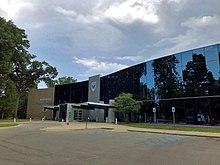
On September 30, 2007, Metro Health Hospital moved from southeast Grand Rapids to its current location on the south central section of Wyoming.[43] Spectrum Health and St. Mary's also have urgent care centers located in Wyoming with their hospitals located in downtown Grand Rapids.
The Wyoming Police Department has over eighty sworn police officers serving as of 2013.[44] In 2014, Wyoming Police Department and Wyoming Fire Department amalgamated their administrative offices into the Police Headquarters building, creating the new entity of Wyoming Department of Public Safety.[45]
Education
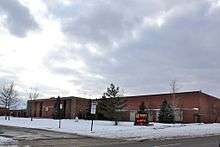
Currently the city is served by 8 school districts. In the southwest panhandle is served by Grandville Public Schools, the south extension of the city by Metro Health is served by Byron Center Public Schools, the central part is served by Wyoming Public Schools, the southeast is served by Kelloggsville Public Schools, the area south of 56th St and East of the railroad tracks is served by Kentwood Public Schools, a small annexed section by Hall St and Freeman Ave is served by Grand Rapids Public Schools, the northeast is served by Godwin Heights Public Schools, and finally the northern section of the city is served by Godfrey-Lee Public Schools.
Of the eight districts only 4—Grandville Public Schools—does not have the majority of the buildings in the city. Grand Rapids Public Schools, Kentwood Public Schools and Byron Center Public Schools do not have any schools in the City of Wyoming. The remaining have 13 elementary schools, 3 out of 13 middle schools, 4 out of 8 high schools, with Godfrey-Lee providing a combination middle high school in the city.
The Potter's House, a Christian K-12 school, maintains its high school campus in Wyoming.[46] Holy Trinity Lutheran School is a Pre-K-8 grade school of the Wisconsin Evangelical Lutheran Synod in Wyoming.[47]
The city is also served for college by Grand Rapids Community College in downtown Grand Rapids. In Allendale, northwest of the city, is Grand Valley State University. Further universities can be found in Lansing, Big Rapids, and Kalamazoo. Also located in the immediate area is Hope College in Holland, Davenport University in Caledonia Township, Calvin College on the east side of Grand Rapids, Aquinas College also on the east side of Grand Rapids, Cornerstone University on the northeast side of Grand Rapids, along with Grace Bible College in the city as well. The Protestant Reformed Theological Seminary located in 4949 West Ivanrest Ave Wyoming, Michigan.[48]
Infrastructure
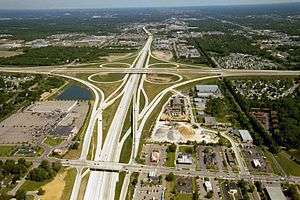
Transportation
Public Transit
The city is part of the Grand Rapids-based Interurban Transit Partnership, called the Rapid. It currently runs Routes 1, 3, 8, 10, 16, 24, 28, and 44 in the city; that is 8 out of the 26 routes. Currently the U.S. Department of Transportation is funding a good portion of a new transit system for the area. It will run along Division Avenue on the east side of the city from its southernmost point to the downtown. It is a bus rapid transit system with only 5 projected stations on the route inside of the city. The new line will be run by the Rapid.
Major highways





Utilities
Currently the city provides water and sewer to the majority of the citizens. Electricity is supplied by Consumers Energy with natural gas nominally supplied by DTE Energy. Garbage service is supplied by individual contractors to home owners and by law they are required to use the county incinerator although the city does provide a yard waste drop off center. For both phone and cable service is supported by both AT&T and Comcast. Cell phones carriers are on the whole fully supported with a number of towers.
Notable people
- Chris Kaman – NBA center – New Orleans Hornets
- Buster Mathis – professional boxer
- Buster Mathis, Jr. – heavyweight champion professional boxer
- Drew Neitzel – Michigan State University basketball guard
References
- "2019 U.S. Gazetteer Files". United States Census Bureau. Retrieved July 25, 2020.
- "U.S. Census website". United States Census Bureau. Retrieved November 25, 2012.
- "Population and Housing Unit Estimates". United States Census Bureau. May 24, 2020. Retrieved May 27, 2020.
- "U.S. Census website". United States Census Bureau. Retrieved January 31, 2008.
- "US Board on Geographic Names". United States Geological Survey. October 25, 2007. Retrieved January 31, 2008.
- Vaughn, Charles; Simon, Dorothy (1984). The City of Wyoming: A History. Franklin, Michigan: Four Corners Press. p. 1.
- History of Kent County, Michigan: Together with Sketches of Its Cities, Villages and Townships. Chicago, Illinois: C. C. Chapman & Company. 1881. pp. 1408–1426.
- Vaughn, Charles; Simon, Dorothy (1984). The City of Wyoming: A History. Franklin, Michigan: Four Corners Press. p. 10-12.
- History and Directory of Kent County, Michigan: Containing a History of Each Township, and the City of Grand Rapids. Daily Eagle Steam Printing House. 1870. pp. 107–113.
- Vaughn, Charles; Simon, Dorothy (1984). The City of Wyoming: A History. Franklin, Michigan: Four Corners Press. pp. 2–4.
- "Illustrated historical atlas of the county of Kent, Michigan". quod.lib.umich.edu. Retrieved June 25, 2020.
- Walter Romig, Michigan Place Names, p. 198
- Vaughn, Charles; Simon, Dorothy (1984). The City of Wyoming: A History. Franklin, Michigan: Four Corners Press. pp. 22–33.
- Vaughn, Charles; Simon, Dorothy (1984). The City of Wyoming: A History. Franklin, Michigan: Four Corners Press. pp. 35–76.
- Vaughn, Charles; Simon, Dorothy (1984). The City of Wyoming: A History. Franklin, Michigan: Four Corners Press. pp. 168–173.
- Vaughn, Charles; Simon, Dorothy (1984). The City of Wyoming: A History. Franklin, Michigan: Four Corners Press. pp. 168–173.
- Vaughn, Charles; Simon, Dorothy (1984). The City of Wyoming: A History. Franklin, Michigan: Four Corners Press. pp. 77–112.
- Vaughn, Charles; Simon, Dorothy (1984). The City of Wyoming: A History. Franklin, Michigan: Four Corners Press. pp. 22–33.
- "Rogers Department Store". WKTV. Retrieved July 11, 2020.
- Lewis, Norma; de Vries, Jay (December 13, 2010). Wyoming. Arcadia Publishing. pp. 22–59. ISBN 9781439641064.
- "Michigan". CSA Super Markets. Lebhar-Friedman. 36: 49. 1960.
- "Studio 28 History Timeline". Celebrationcinema.com. Retrieved June 10, 2014.
- Daly, Pete (November 15, 2010). "Wyoming to focus on look at 28th Street". The Grand Rapids Business Journal.
- "Cinemas Around the World - Studio 28 Theatre, Wyoming MI". CinemaTour. Retrieved June 10, 2014.
- "TURN ON 28TH STREET" (PDF). City of Wyoming. Retrieved August 18, 2016.
- Shandra Martinez | smartinez@mlive. com (November 8, 2012). "How Gordon Food Service's new 'breathtaking' headquarters makes a statement". MLive. Retrieved July 11, 2020.
- McAboy, Koco (June 24, 2016). "28 West project in Wyoming moving forward". WOOD-TV. Retrieved August 18, 2016.
- Lewis, Norma; de Vries, Jay (December 13, 2010). Wyoming. Arcadia Publishing. pp. 132–143. ISBN 9781439641064.
- ""28 West": City Of Wyoming Looking To Transform 28th Street". FOX17. August 28, 2013. Retrieved August 18, 2016.
- "Comprehensive Annual Financial Report For Fiscal Year Ended June 30, 2017" (PDF). City of Wyoming. Retrieved August 15, 2016.
- "Parks". Parks & Recreation Department, City of Wyoming. Retrieved November 2, 2010.
- "Wyoming Senior Center". Parks & Recreation Department, City of Wyoming. Retrieved November 2, 2010.
- "Kent Trails". Kent County Parks Department. Retrieved November 2, 2010.
- "Wyoming Dog Park". Parks & Recreation Department, City of Wyoming. Retrieved November 2, 2010.
- "Wyoming Branch" (PDF). Kent District Library. Retrieved November 2, 2010.
- "Wyoming Historical Commission". Wyoming Historical Commission, City of Wyoming. Retrieved November 2, 2010.
- "History". 28th Street Metro Cruise. Retrieved November 2, 2010.
- Fisher, Ernest B. (1918). Grand Rapids and Kent County, Michigan: Historical Account of Their Progress from First Settlement to the Present Time, Volume 1. Robert O. Law Company. pp. 293–300.
- "US Gazetteer files 2010". United States Census Bureau. Archived from the original on January 12, 2012. Retrieved 2012-11-25.
- "Historical Weather for Grand Rapids, Michigan". Weatherbase. Retrieved November 12, 2008.
- Lewis, Norma; de Vries, Jay (December 13, 2010). Wyoming. Arcadia Publishing. pp. 78–88. ISBN 9781439641064.
- "Roosevelt Park CRC's Building Sold". Christian Reformed Church. September 9, 2015. Retrieved July 12, 2020.
- "History". Metro Health. Retrieved November 13, 2010.
- "City of Wyoming > About Wyoming > City Departments > Public Safety - Police". www.wyomingmi.gov. Retrieved July 12, 2020.
- "City of Wyoming > About Wyoming > City Departments > Public Safety - Police". www.wyomingmi.gov. Retrieved July 12, 2020.
- "Home". The Potter's House. Retrieved November 24, 2019.
High School 2465 28th Street Wyoming, MI 49509
- "Holy Trinity Lutheran School".
- Protestant Reformed Theological Seminary website, prca.org; accessed December 23, 2014.
